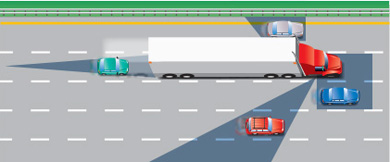Sharing the road with large commercial vehicles
It is extremely important to know how to drive safely when sharing the road with large commercial vehicles such as tractor-trailers and buses. Recent data show that the majority of fatalities resulting from collisions involving large commercial trucks are not the result of the truck driver’s actions, but of the other driver’s actions. Therefore, sharing the road with large commercial vehicles means you must always be aware of a large vehicle’s capabilities and limitations, such as of the following:
1. Blind Spots – Large commercial vehicles have big blind spots on both sides. Avoid tailgating a large vehicle. The driver cannot see you if you are directly behind. If the vehicle stops suddenly, you have no place to go. Remember that if you can’t see the driver’s face in the large vehicle’s side-view mirror, the driver cannot see you.

Diagram 2-15
2. Stopping Distance – Large commercial vehicles require a much longer distance to stop than smaller vehicles. When passing a large vehicle, do not cut in front closely. Not only is this discourteous, it is dangerous; it reduces the space cushion large vehicles require in order to stop safely. Allow more room when passing a large vehicle.

Diagram 2-16
3. Wide Turns – When making a right turn, a large vehicle may need to first swing wide to the left and around, in order to avoid hitting the right curb. If a large vehicle in front of you is making a right turn, do not move up into the space that opens up in the right lane; you are putting yourself into a very dangerous position. Once the front of the vehicle has cleared the corner, the rest will move partially back into the right lane. If you are in that lane, your vehicle will be squeezed between the trailer and the curb. Stay well back until the truck has completely cleared the lane.
This situation can occur on expressway off-ramps that have two left turning lanes. Do not drive up into the left lane when a large vehicle is making a left turn in front of you. Stay well back until the truck has cleared the left turn, or else you may get squeezed between the truck and the curb.
4. Rolling Back – Leave plenty of room if you are stopped behind a large vehicle. When the driver of a large vehicle releases the brakes after being stopped, the vehicle may roll back.
5. Spray – In bad weather, large vehicles are capable of spraying up large amounts of mud, snow and debris, which could land on your windshield and temporarily block your vision.
6. Turbulence – Due to various factors such as air pressure and airflow, a large vehicle can create heavy air turbulence. This may affect your ability to control your vehicle when passing a large one.
